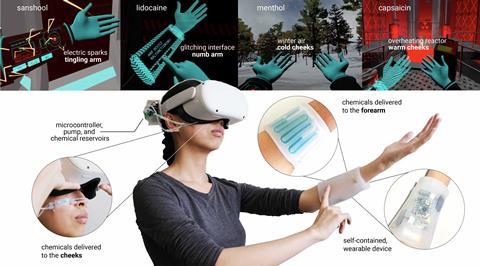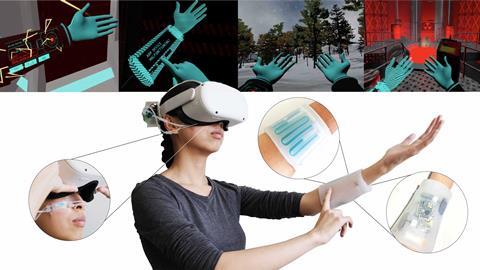By applying chemicals to the skin, researchers from the University of Chicago have created a new form of haptics that make VR-experiences more real. The system isn’t perfect yet, but it could be a way to enrich the world of gaming. And perhaps, it may even offer medical applications in the future. C2W International visited Chicago for a real-life demonstration.
I’m standing in a forest. The ground is covered in snow, and big snowflakes are coming down from the sky. I try to catch them with my hands, but it is quite difficult. But the longer I try, the more I start to feel cold stings of the snowflakes on my left arm. But when I look down, I don’t see my body, my hands and forearms are just floating in the air. The game ends, and I take off my Virtual Reality-headset.
Researchers and technology companies are constantly trying to create a more realistic VR-experience. To fully achieve a sense of reality, you not only need to trick the eyes, but also the body. Haptics is the way to do this. Haptic systems can imitate our sense of touch by using electronics that, for instance, vibrate or apply force to your skin. They can be put in a glove or even a complete bodysuit. However, these systems are not perfect – they often consume a lot of energy and are come with bulky batteries or generators. US-based researchers have now come up with a completely different approach to haptics: they trick the body by using chemicals.
At the Department of Computer Science at the University of Chicago, I visit the lab where PhD students Jasmine Lu and Jas Brooks show me around and give me a demo to experience how their system works. ‘We do research on the interface of the human body and machines, like computers’, Lu says. ‘These interfaces require different ways of interacting, depending on what you want to achieve. In this project, we wanted to see if we could use the properties of human skin to make a haptic-like system.’
‘We bought most products from the pharmacy and supermarket’
Shopping
The idea of using chemicals to elicit sensations in the skin is based on known biology. ‘We know which receptors are responsible for certain sensations’, Lu explains. ‘You have hot and cold receptors, and a bunch of other ones. We searched for chemicals that would bind to those receptors.’ To find the right compounds, they simply went shopping. ‘We bought most products from the pharmacy and supermarket’, Brooks tells me. ‘That way, we looked for chemicals that are used in food or skin products, so we knew they would be safe to use.’
They ended up with menthol, capsaicin, methyl salicylate, cinnamaldehyde, sanshool, and lidocaine. Lu: ‘We found that these chemicals would bind to different receptors, and give changes in temperature, but also lead to itchiness, pain and numbness. Menthol binds to the TRPM8 receptor, which makes you feel cold. Sanshool works on the mechanoreceptors, and makes you feel like something is touching your skin.’

Plastic band-aid
In the VR-game, Lu and Brooks want me to play in a cold environment, so they apply menthol. In their study, an elaborate glove with built-in channels was used, but for this short demo they have a simpler device that resembles a thick, plastic band-aid with channels running through. The device is attached to my arm with some bandage, and a pump pushes the menthol through the channels. ‘The channels in the band-aid have small holes, so this is how the menthol gets delivered to your skin’, Lu explains.
The effect takes a while to arise, because the menthol first needs to be absorbed by my skin. After about two or three minutes of playing, I start to feel cold, prickly sensation on my forearm. This delay is one of the drawbacks of the system, says Brooks. ‘The chemicals do give a good effect, but the effects aren’t as fast as in real life. However, they are long lasting, so it is both a strength and a weakness.’ The chemical system does allow you to change sensations more easily, Brooks explains: ‘You can just change the chemical. In electronic haptics, you often need a whole new device if you want to change the sensation.’
‘We also looked into smell, and what smelling different chemicals can do to a VR-experience’
Quicker changes
They are now looking for ways to make the system switch faster. Lu: ‘You can use chemicals that counteract certain effects, or maybe wash the receptors clean. We have to test this, to see what works best.’ It would be even better if they found chemicals that can induce multiple sensations, so they wouldn’t have to change. This could happen, as Brooks found out during another experiment. ‘We also looked into smell, and what smelling different chemicals can do to a VR-experience. The gamers would play with a device below their nose. What was interesting is that some players indicated that they felt like they were breathing in fresh cold air, when playing on a mountain. But when the game was set in the desert, they experienced the air as hot and they could feel the sun burning down on them. But in both cases, we made them smell the same chemical.’

Game halls
There is still lots to discover and develop before chemical haptics will find their way to the market. Lu: ‘We now see more and more applications of electronic haptics coming up. This will hopefully lead the way for other types of haptics, like ours.’ Brooks thinks even hybrid systems might be an option: ‘You could utilize chemicals for longer effects, and then use electronic systems for fast changes. This might solve the limitations of both approaches, as you also don’t need as much energy if you use the electronics more sparingly.’ Whatever the system will look like, Lu doesn’t immediately see everyone using chemical haptics at home. ‘It may be better suited for speciality stores or game halls, where they know how to switch the vials and the systems.’
‘I can definitely see these devices helping people by relieving pain’
Besides the gaming-applications, there might also be benefit of chemical haptics in the medical world. ‘I can definitely see these devices helping people by relieving pain’, Brooks says. ‘Or they might be useful for people who lost their sense of touch or smell. Especially with the loss of smell, people are often still able to feel the clearing effect of menthol, of the sharpness of vinegar, without actually smelling the scent. So, our research could play into that.’
Chemosensory
The next step is to increase our knowledge on all the chemosensory processes. Brooks: ‘We will keep on experimenting, and we are also going to look into taste. This could be useful for dietary applications.’ Both researchers are convinced that chemical haptics will become a big thing in the future. ‘We already use haptics a lot’, Brooks says. ‘There are vibrating game controllers, and you use your phone through haptics. There are even people looking into shampoo or skincare products that elicit a certain sensation. Our research can definitely play a role in the everyday world.’
This publication was created with support of the VWN Tripfonds, managed by the ’Vereniging voor Wetenschapsjournalistiek en -communicatie Nederland’.













Nog geen opmerkingen